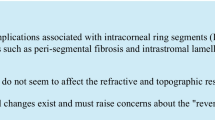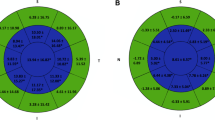Abstract
Purpose
During excimer laser photoablation keratocyte cell death is induced in the retroablation area. Afterwards this area is repopulated by keratocyte mitosis and migration from the adjacent stroma. The aim of this study was to investigate keratocyte density in the retroablation area and in the posterior stroma during the first year after LASEK for the correction of myopia.
Methods
In a prospective study LASEK surgery was performed in 17 eyes of 10 consecutive patients for the correction of myopia (−2.25 D to −9.0 D, mean −5.0 D). Confocal microscopy (Nidek Confoscan 2) was performed before surgery and 1 month, 3 months, 6 months and 12 months after LASEK. Keratocyte density was assessed in the anterior retroablation area at depths of 5 μm and 25 μm and in the posterior stroma at distances of 5 μm and 100 μm from the corneal endothelium and compared with the corresponding area before surgery.
Results
Keratocyte density was statistically significant reduced in the retroablation area at all timepoints after LASEK. At a depth of 5 μm, cell densities were decreased by 64%, 47%, 43%, and 28% at 1 month, 3 months, 6 months and 12 months after LASEK compared with preoperative values. At a depth of 25 μm, cell densities were decreased by 51%, 32%, 28%, and 18% at 1 month, 3 months, 6 months and 12 months after LASEK compared with preoperative values. In the posterior stroma no significant change in keratocyte density was observed at any time after LASEK.
Conclusions
Keratocyte density in the anterior retroablation area recovers during the first year after LASEK for the correction of myopia, but does not go back to preoperative values.

Similar content being viewed by others
References
Balestrazzi E, De Molfetta V, Spadea L, Vinciguerra P, Palmieri G, Santeusanio G, Spagnoli L (1995) Histological, immunohistochemical, and ultrastructural findings in human corneas after photorefractive keratectomy.J Refract Surg 11(3):181–187
Camellin M (1999) LASEK may offer the advantages of both LASIK and PRK. Ocul Surg News Int Edn 3:14–15
Campos M, Raman S, Lee M, McDonnell PJ (1994) Keratocyte loss after different methods of de-epithelialization. Ophthalmology 101(5):890–894
Dawson DG, Edelhauser HF, Grossniklaus H (2005) Long-term histopathologic findings in human corneal wounds after refractive surgical procedures. Am J Ophthalmol 139:168–178
Erie JC, Nau CB, McLaren JW, Hodge DO, Bourne WM (2004) Long-term keratocyte deficits in the corneal stroma after LASIK. Ophthalmology 111(7):1356–1361
Erie JC, Patel AV, McLaren JW, Nau CB, Hodge DO, Bourne WM (2003) Keratocyte density in the human cornea after photorefractive keratectomy. Arch Ophthalmol 121:770–776
Frueh BE, Cadez R, Bonke M (1998) In vivo confocal microscopy after photorefractive keratectomy in humans. A prospective, long-term study. Arch Ophthalmol 116(11):1425–1431
Freund DE, McCally RL, Farrell RA, Cistol SM, L’Hernault NL, Edelhauser HF (1995) Ultrastructure in anterior and posterior stroma of perfused human and rabbit corneas. Relation to transparency. Invest Ophthalmol Vis Sci 36:1508–1523
Gierek-Ciaciura S, Mrukwa-Kominek E, Rotika-Wala I, Wygedowska -Promienska D (2003) Structural changes in the cornea after LASIK during the early postoperative period. Klin Oczna 102(5):335–338
Helena MC, Baerveldt F, Kim WJ, Wilson SE (1998) Keratocyte apoptosis after corneal surgery. Invest Ophthalmol Vis Sci 39(2):276–283
Kermani O, Lubatschowski H (1991) Structure and dynamics of laser-induced acoustic shockwaves in 193 nm excimer laser photoablation of the cornea. Fortschr Ophthalmol 88:748–753
Laube T, Wissing S, Theiss C, Brockmann C, Steuhl KP, Meller D (2004) Decreased keratocyte death after laser-assisted subepithelial keratectomy and photorefractive keratectomy in rabbits. J Cataract Refract Surg 30:1998–2004
Lohmann CP, Winkler von Mohrenfels C, Gabler B, Herrmann W, Müller M (2002) Excimer Laser Subepitheliale Ablation (ELSA) bzw. Laser Subepitheliale Keratomileusis (LASEK)—ein neuartiges refraktiv- chirurgisches Verfahren zur Myopiekorrektur. Operationstechnik und erste klinische Ergebnisse an 24 Augen und nach 3 Monaten. Klin Monatsbl Augenheilkd 219:26–32
Lubatschowski H, Kermani O, Otten C, Haller A, Schmiedt KC, Ertmer W (1994) ArF-excimer laser-induced secondary radiation in photoablation of biological tissue. Lasers Surg Med 14:168–177
McLaren JW, Nau CB, Kitzmann AS, Bourne WM (2005) Keratocyte density: comparison of two confocal microscopes. Eye Contact Lens 31(1):28–33
Marchant JK, Zhang G, Birk DE (2002) Association of type XII collagen with regions of increased stability and keratocyte density in the cornea. Exp Eye Res 75:683–694
Mohan RR, Hutcheon AEK, Choi R, Hong J, Lee J, Mohan RR, Ambrosio R, Zieske JD, Wilson SE (2003) Apoptosis, necrosis, proliferation, and myofibroblast generation in the stroma following LASIK and PRK. Exp Eye Res 76:71–87
Moller-Pedersen T, Li HF, Petroll WM, Cavanagh HD, Jester JV (1998) Confocal microscopic characterization of wound repair after photorefractive keratectomy. Invest Ophthalmol Vis Sci 39(3):487–501
Nakayasu K (1998) Stromal changes following removal of epithelium in rat cornea. Jpn J Ophthalmol 32(2):113–125
Patel SV, McLaren JW, Hodge DO, Bourne WM (2001) Normal human keratocyte density and corneal thickness measurement by using confocal microscopy in vivo. Invest Ophthalmol Vis Sci 42:333–339
Shimmura S, Masumizu T, Nakai Y, Urayama K, Shimazaki J, Bissen-Miyajima H, Kohno M, Tsubota K (1999) Excimer laser-induced hydroxyl radical formation and keratocyte death in vitro. Invest Ophthalmol Vis Sci 40:1245–1249
Wilson SE, He YG, Weng J, Li Q, McDowell AW, Vital M, Chwang EL (1996) Epithelial injury induces keratocyte apoptosis: hypothesized role for the interleukin-1 system in the modulation of corneal tissue organization and wound healing. Exp Eye Res 62:325–337
Zieske JD, Guimaraes SR, Hutcheon AE (2001) Kinetics of keratocyte proliferation in response to epithelial debridement. Exp Eye Res 72:33–39
Author information
Authors and Affiliations
Corresponding author
Rights and permissions
About this article
Cite this article
Herrmann, W.A., Muecke, M., Koller, M. et al. Keratocyte density in the retroablation area after LASEK for the correction of myopia. Graefe's Arch Clin Exp Ophthalmol 245, 426–430 (2007). https://doi.org/10.1007/s00417-006-0344-0
Received:
Revised:
Accepted:
Published:
Issue Date:
DOI: https://doi.org/10.1007/s00417-006-0344-0




